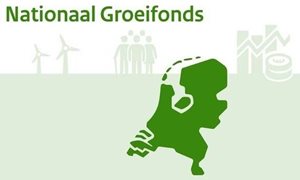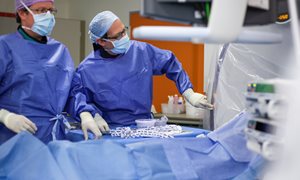
Primary liver tumors are among the most common cancers worldwide. Unfortunately, only 10–20% of patients can undergo potentially curative treatments like surgery or transplantation. For most patients, the options are palliative treatments, such as radioembolization (RE). RE involves injecting radioactive microspheres through a catheter, which will lodge in the tumor vasculature, emitting radiation into the tumor tissue. However, the success of this treatment varies: some patients benefit and live longer, while others see limited improvement. A combined multidisciplinary team of the University of Twente and the Radboud university medical center (Radboudumc) aims to change this, thanks to a grant from the TURBO program.
(Illustration: MRI testing liver perfusion with microspheres and microbubbles)
Erik Groot Jebbink, assistant professor specializing in medical imaging at the University of Twente (TechMed Centre), and Frank Nijsen, associate professor at the Medical Imaging Department at the Radboudumc, will conduct an innovative pilot study to increase the accuracy and effectiveness of RE by using gas-filled microbubbles.

Team Radboudumc: left to right: Ilse Spenkelink, Joey Roosen, Frank Nijsen
Microbubbles for cancer treatment
Repurposing harmless gas-filled microbubbles can help identify the best location for placing the catheter. Using ultrasound imaging, the team can track where microbubbles accumulate in the tumor's blood vessels and determine the catheter position that will deliver the highest concentration of radioactive microspheres to the tumor. Administering the radioactive microspheres into these targeted areas increases their effectiveness in treating the tumor.
Their team will also examine whether it is possible to make the microbubbles expand and burst. This would generate just enough force to cause minor damage to the blood vessels of the tumor, making them more susceptible to the radiation emitted by the microspheres.
First in Europe
This project is one of the first in Europe to explore gas-filled microbubbles in combination with radioactive holmium microspheres. It could complement current treatment strategies for people with liver cancer in the Netherlands and across Europe.
The initial experiments will be carried out in the laboratory at the University of Twente (TechMed Centre), where scientists will investigate if it is safe to use microbubbles alongside the radioactive microspheres. After additional testing to see how the blood flow distributes microbubbles and radioactive microspheres within a pig liver, the treatment will be tested on a small number of patients to confirm its safety in humans.
Impact on liver cancer treatment
Groot Jebbink and Nijsen explain: “We anticipate the ultrasound-guided microbubble treatment to be a highly cost-effective addition to the standard treatment of liver tumors. In the United States, patients treated with other combinations of radioactive particles and microbubbles experienced improved outcomes. Our study aims to demonstrate that using holmium microspheres and microbubbles can also be safe and beneficial.”
The team relies on different imaging techniques. Ultrasound is used to track microbubble movement, determine optimal catheter placement, and induce bubble expansion and bursting. MRI and SPECT scans visualize the distribution of radioactive microspheres in the body.

Team Twente University: Erik Groot Jebbink, Shannen Ubbink
Challenges
Several challenges will be explored in this proposal. The first challenge is if microbubbles will indeed predict how microspheres spread in the liver and around the tumor. Pig livers serve as a good model to test whether the bubbles and microspheres reach the same location. However, it is difficult to determine whether the microbubbles also indicate the quantity of microspheres, as the microspheres—unlike the microbubbles—become trapped in the blood vessels. This is a crucial part of the research.
Another challenge is using the microbubbles to make the blood vessels more susceptible to the radiation emitted by the microspheres. To achieve this, it is important to determine the optimal timing and sequence for administering microspheres and microbubbles, as well as whether the microbubble treatment of the blood vessels should be repeated.
The final challenge is translating the research findings into clinical practice. The team will need to compile a detailed report demonstrating that the combination of microbubbles and microspheres can be safely applied. Additionally, it must be determined whether the treatment can be effectively implemented in medical settings. This part will be carried out in the Radboudumc.
Looking forward
This study marks the first step in introducing a new treatment approach, and further research will focus on optimizing the dosage and timing of the treatment. In the long term, larger clinical trials involving multiple hospitals will follow to determine the overall effectiveness of the treatment.
Groot Jebbink and Nijsen will also explore whether the current microbubbles are the best option or whether they can be further refined for even better results. They conclude, “Our work shows how microbubbles can significantly change a complex and expensive treatment, potentially improving outcomes for many patients.”
HealthTech Nexus and the TURBO program
HealthTech Nexus is the strategic collaboration between Radboudumc and the University of Twente (TechMed Centre) at the intersection of healthcare and medical technology. Together they focus on the 'unmet need' of healthcare: urgent needs for which no good solutions yet exist.
This strategic platform brings together knowledge and expertise within a broad network of stakeholders inside and outside the healthcare sector. To keep tomorrow's care patient-oriented, sustainable, affordable and accessible, cooperation is crucial. Other parties are explicitly invited to join.
Groot Jebbink and Nijsen’s project is one of four projects honored by the TURBO program (Twente University RadBoudumc Opportunities).
HealthTech Nexus is the strategic collaboration between the Radboudumc and the University of Twente at the intersection of healthcare and medical technology.
For more information on HealthTech Nexus and the TURBO program visit University of Twente (TechMed Centre) or Radboudumc.
*Frank is scientific advisor to Quirem Medical one day a week.
-
Want to know more about these subjects? Click on the buttons below for more news.



_1.jpg?width=500&height=333&ext=.jpg&type=BlockColumn1Zoom1)



